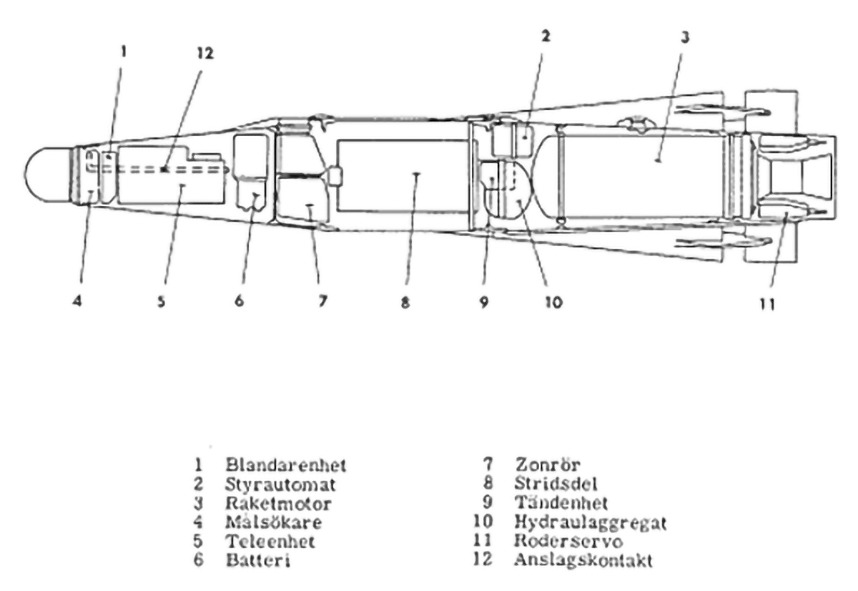- Yes
- No
RB 27 / AIM-26B Falcon missile for the J35XS & for the future addition of the J35F & J35J:
Image: RB 27 Falcon on display at Uppsala Garnisonsmuseum.
The RB 27 is a export variant of the Hughes Aircraft Company AIM-26B Falcon: Which was a American made, radar guided Air-To-Air Missile. The primary user of this missile, was used on the Saab J35F Draken and J35J respectively (Note: The J35XS were also able to be equipped with these missiles). The Swedes, already way back in 1958: Were discussing and negotiatating with the Americans in the regards of aquiring new type of Air-To-Air Missiles for the upcoming J35F Draken variant. Which the requirements of the missile was to be able to engage Soviet bomber aircrafts at a high altitude, long distances and in all types of weather conditions and during night-time operations.
Their inital plan Sweden had, was to only aquire the AIM-4 Falcons: The GAR-1 with a semi-active radar seeker and GAR-2 with a IR-Seeker respectively. However, due to the low explosive yield which the missile had for the Semi-Active radar version of the AIM-4 Falcon (GAR-1): The Swedish Airforce/Goverment opted instead on aquiring the more powerful AIM-26B Falcon: GAR-11. Which would be equipped with a semi-active radar seeker, which were compatible with the PS-01/011 Sighting Radar (Which were to be equipped on the J35F/J).
However, due to the AIM-26 Falcon was originally equipped with a nuclear warhead: The missile was modified and re-equipped with a conventional warhead instead. (Sidenote: The Swedish Airforce did also aquire the AIM-4 Falcon with the IR-Seeker. But instead of the GAR-2 which was originally planned, they instead bought the GAR-4 variant. But that missile will be it’s own suggestion in the future).
The now designated RB 27 / AIM-26B / HM-55 (By Hughes Aircraft Company), was license purchased and produced by Saab, Bofors and LM Eriksson (Depending on all of the different parts of the missile.) and were introduced to the Swedish Airforce in 1965. The RB 27 would see active service in the Swedish Airforce up till the Saab J35’s were completely phased out of service in 1999.
However, as time progressed: The issue which the RB 27 had similarly to it’s American counterpart: Was it’s radar proximity fuse. The problem which the missile had, was it’s limitations in altitude. Especially over bodies of water (Ie. lakes and oceans) and if the missile flew below 700 meters of flight altitude: It could cause the missile to trigger it’s warhead prematurely. In the late 1980s and for adaptation to the coming J35J, the proximity fuse was modified and improved so it could also operate at a much lower altitude: Then thereafter, the RB 27 was capable of functioning below 50 meters of flight altitude (Including over bodies of water). Note: The J35F also used the upgraded RB 27 missiles until the aircraft was phased out of service/replaced by the J35J.
Specifications:

| RB 27 / AIM-26B Falcon | |
|---|---|
| Weight (Total): | 116,5 kg |
| Weight (Warhead): | 6,6 kg |
| Length: | 2,169 meters |
| Width: | 0,620 meters |
| Arming conditions: | Acceleration >40 g for 0.8 seconds |
| Arming Time: | 1~2 Seconds |
| Arming time delays (Proximity fuse initiation for rear attack): | 9 milliseconds |
| Self-destruction time (In-Flight): | 25~27 seconds |
| Max speed: | Mach 1,4 + Depending on the aircrafts speed when missile was launched |
| Thrust: | ~25000 N / ~25 kN |
| Thrust (Time): | 2~3 Seconds |
| Guided missile flight time (at 3000 meter altitude): | 14~15 Seconds |
| Frequency range: | X-Band (8-12,5 GHz) |
| Seeker lobe width: | Stationary: 25 degrees. During rotation: 50 degrees. |
| Seeker’s maximum deflection angle: | 45 degrees |
| Seeker’s maximum precision rate: | 6 degrees/second |
| Seeker’s maximum tracking rate: | 10 degrees/second |
Sources:
https://robotmuseum.se/robotar/jaktrobot-rb27-och-rb28-falcon/
https://robotmuseum.se/wp-content/uploads/RBM_ARM_RB27-28.pdf
